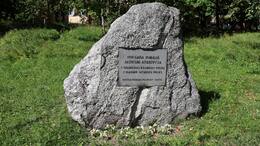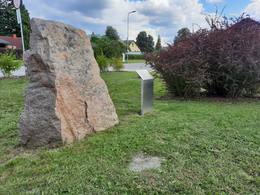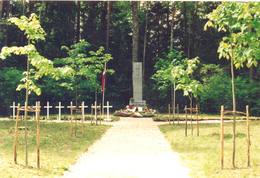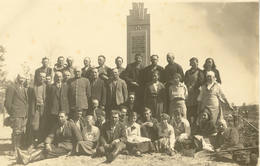Anšlavs Eglītis's memories of the Latvian War of Independence and the events of 1919 in Alūksne

On March 27, 1919, the 1st Valmiera Infantry Regiment, together with the Estonian Guards (kaitselit) battalions of Tallinn (then Rēvele) and Tērbatas, as well as three armored trains, began the liberation of Latvia from the Bolsheviks from the banks of the Melnupe River.
“At that time, the change of troops and powers provided plenty of entertainment. Germans, White Russians, Red Russians, Estonians, Finns, even Danes in beautiful, knee-length boots. One such scene in particular is deeply etched in my memory. The unfortunate Latvian riflemen who remained on the Red side, a small group, held Alūksne for a long day against two Finnish volunteer companies that had come to the aid of the Estonians. The Red Russian battalion, in complete panic early in the morning, rushed through Alūksne, heading east. Many Russians ran without weapons, so that only their valenki flashed and their long overcoats fluttered in the air. Every moment we expected the Finns to arrive, who had the reputation of being mighty, “monstrous” warriors. But nothing happened. The small towns On the other side of the hill, shots were blaring, machine guns were rattling. We listened to see if shots were also being fired to the right and left, which would mean a evasive maneuver, but the burly Finns were probably already charging straight at Alūksne. This continued all day until dusk. Then silence fell. After a while, riflemen appeared in the church square. About fifteen, no more. No commands or words were heard. With their heads bowed like tired workers, carrying their tools over their shoulders, they walked slowly, calmly, past the windows of our house towards the lake road that led across the frozen plain. One of the walkers had his head and hand bandaged. The other limped with a leg covered in blood. A more seriously wounded comrade was being dragged along on a wheeled Maxim machine gun. His hanging head bobbed to the rhythm of the steps… The riflemen heroism had a special irony. They covered the retreat of the Russian conquerors who were hostile to their people. And where did they retreat themselves? Away from their own land, into a foreign land, where they were not awaited by gratitude at all, but only by suspicion, envy, repression and liquidation. (..) Finally, in late spring, with a brave song on their lips, the brave soldiers of Latvia marched into Alūksne. To stay!”
Anšlavs Eglītis. “The Great Mute”. // Latvian Youth, June 12, 1991, No. 59.
Related timeline
Related topics
Related objects
Memorial stone to the liberators of Alūksne
Located in Alūksne, at the intersection of Helēnas and Alsviķu streets.
The memorial stone was unveiled on May 29, 1999, on the 80th anniversary of the liberation of Alūksne. The stone carving work was carried out by sculptor Ainārs Zelčs.
On March 31, 1919, the Northern Latvian Brigade was founded in the city of Tartu, with the task of liberating Vidzeme and Latgale. The brigade consisted of the combined 1st Valmiera and 2nd Cēsis Infantry Regiments, later also the Northern Latvian Partisan Regiment, two cavalry squadrons and two artillery batteries. On May 26, these forces occupied Valmiera, but on May 27, the 1st Valmiera Infantry Regiment, together with the 2nd Estonian Cavalry Regiment, launched an attack in the direction of Alūksne. The Bolsheviks were unable to repel further attacks, and on May 29, 1919, Alūksne was liberated.
Memorial stone to the Finnish volunteer regiment "Boys of the North"
Located in Alūksne, at Jāņkalna Street 52, near the Alūksne narrow-gauge railway station.
On February 23, 2019, to mark the centenary of the Latvian War of Independence, at the initiative of the Independence Struggle Traditions Association (Finland), a special memorial site was created to honor the Finnish volunteers who fell for Latvia's independence, where a special boulder and an information plaque testify to the historical events. The memorial stone traveled to Alūksne from Finland - the Salpa Line, which was built in 1940-1944 to protect Finland's Eastern border. The 1,200 km long Salpa Line is one of the most notable defense lines of independent Finland, as well as one of the strongest and best-preserved defense structures of this type in Europe after World War II.
The stone brought to Alūksne symbolizes the struggle of two peoples - the Finns and the Latvians - for their independence. The Finnish volunteer regiment "Boys of the North" went to help the Latvians protect the freedom of the new Latvian state. On February 21, 1919, the "Boys of the North" participated in fierce battles in the vicinity of Alūksne (Marienburg). After a five-hour battle near the Alūksne railway station, the Finns took Alūksne. In this battle, 23 Finnish volunteers lost their lives and many were wounded.
Karva Brothers Cemetery
Located on the side of the Alūksne - Ape road near Zuši mājas, south of Karva, at the turnoff to Rezakas.
The monument was unveiled on September 12, 1937. The granite stele was made at the O. Dambekalns stone quarry in Riga, after a design by the War Construction Administration architect Vemers Vitands.
In the autumn of 1975, local communists destroyed the monument. On March 30, 1989, the Alūksne District Council made a decision to restore the monument, and on April 30, 1989, a temporary wooden memorial in the form of a Latvian grave marker was installed in its place, made by Jānis Jaunzems, a worker at the State Electrical Factory (VEF). The inscription on it read: “The Karva Brothers Cemetery Monument will be restored here.”
At that time, the nearby Brothers' Cemetery was also improved.
In 1993, thanks to the initiative of Ulda Veldre, head of the Alūksne Brothers' Cemetery Committee, the restoration work of the memorial site resumed. The new monument was made by the Cēsis stonemason brothers Aivars, Austris and Auseklis Kerliņi.
The monument was unveiled on June 11, 1994.
Four soldiers of the 5th company of the Valmiera Infantry Regiment are buried in the fraternal cemetery - Jēkabs Sukse, Pēteris Leitlands, Ernests Puķītis and Gustavs Ozols, who fell in the battles near Zuši on April 2, 1919. The fifth soldier buried in the mid-1930s was Roberts Glazners, a soldier of the Valmiera Regiment who disappeared without a trace on March 31, 1919 near Jaunā muiža. Initially, he was buried as an unknown, but later his name was clarified and engraved on a monument. In turn, the fifth soldier who fell in the Battle of Zuši, Augusts Dzedons (Ziedons), is buried in the Apekalna cemetery.
A memorial plaque has been installed at the foot of the monument to Jānis Goldes (1891–1952), a participant in the Battle of Eels, who died in the communist concentration camp in Inta, Komi.
The second memorial plaque, unveiled on August 23, 1992, is installed near one of the wooden crosses and is dedicated to Corporal Pēteris Jansons of the 7th Sigulda Infantry Regiment, who was murdered by the departing communists on July 7, 1941.
Monument to the soldiers of Anna Parish who fell in World War I and the Latvian Liberation War
Located in the central part of the Ezeriņi cemetery in Anna parish.
In the cemetery, where burials have been held since 1925, there is a monument erected with funds collected by the Annas parish Guards Department and opened in 1933 to the soldiers of Annas parish who fell in World War I and the Latvian Liberation War. Until World War II, the Annas parish guards took care of the maintenance of the monument, who went to the cemetery every Sunday and, honoring the fallen, laid flowers. On November 18, 1940, the monument was shot down, the traces left by the bullets are still visible. Nowadays, commemorative events dedicated to Lāčplēsis Day are held in the cemetery every year.
In 2004, a memorial site was opened in the cemetery for those politically repressed in 1941 and 1949, and in 2006, a memorial plaque was opened for national partisans.








